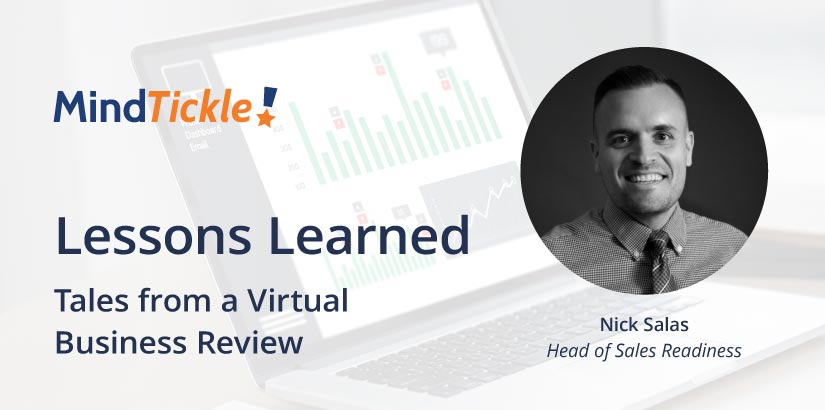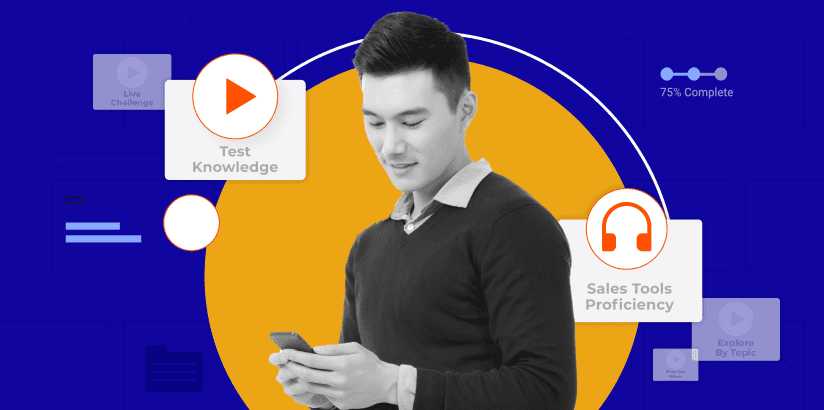This month, we held our second all-virtual sales QBR (Quarterly Business Review) here at Mindtickle, and like the one we held last quarter, we had some successes, but more importantly some lessons learned. These points are what I want to focus on here in order to help fellow enablement professionals as they are thinking about executing all-virtual events, especially ones that hold as much importance to field reps as a QBR does.
The Successes
Success #1: Gathering input from the teams is extremely important not only for setting the agenda, but also creating an atmosphere of collaboration. I sent a survey beforehand asking the field if they preferred two half-days, or one longer day of sessions. The consensus was that two half-days would be better, so we delivered sessions over two days, 4-hours a piece. This small change helped keep attention towards the sessions without getting Zoom fatigue. Also, using Mindtickle’s pre-built templates helped ensure that the content over the two days was aligned with the time expectations of the field.
Success #2: Pre-work is just as essential if not more so than the actual QBR itself. Work done before fosters engagement with the team that will help them get more out the session. The pre-work we asked the field to complete included a series of videos highlighting each session with the following:
- 3 objectives the participants can expect to learn as a result of the session
- Best next action or takeaway that the rep can expect to take back to their territory as a result of the session
- An opportunity to ask the presenter a question based on the topic they were planning to present
Completing this pre-work allowed the participants to get a glimpse of the agenda while providing context. An additional benefit is this drives more interactivity during the actual sessions with the built-in questions as pre-work.
Success #3: Another part of the pre-work was their response to a simple question: What do you want to learn at the QBR? We caveated that with the fact that we would not be able to address all topics, but I took the feedback and customized the topics to cater to the specific needs of the field. More importantly, as we prepped the presenters, we were able to verify that their topics matched the expectations of the team, which we further emphasized during our dry runs with each presenter.
Success #4: Having a theme for your QBR provides focus for the agenda, the speakers and the presentations. Last QBR, I wasn’t explicit or direct with a theme. This time, however, I made sure that our theme was emphasized in some form during each of the presentations. Additionally, the post-work we set up to follow QBR was specifically tied to the theme in order to reiterate the importance to the field. Furthermore, we put together role-play exercises so the field felt more confidence around that theme.
Lessons to Remember
Lesson learned #1: Keeping speakers on schedule and within their allotted times is difficult no matter how much you plan. But within a virtual environment, this is even more essential. Although some flexibility is required, virtual meetings can quickly get out of hand in terms of time allotments, and it is important to moderate the time slots and keep presenters on topic. Always provide some buffer in the time allotted to each speaker and build that into your schedule.
Lesson learned 2: Ensure the team is engaged is a challenge regardless of how much you plan especially because of the volume of content and topics. For me, organizing sessions through a sales readiness platform such as Mindtickle allows other presenters and participants to review the agenda and enroll in individual sessions ahead of time. Also, I used quizzes and games tied to a leaderboard to showcase team members completed assignments and retained knowledge of what they learned.
Lesson learned 3: No matter how much you shorten the agenda, QBRs require a significant time commitment from the team. The virtual QBR is even more difficult because you’re either focusing on the video call intently or you’re easily distracted (e.g. emails, phone, etc.). So remember to build in sufficient breaks for attendees. I like to fill breaks with small tasks and knowledge checks, but it is important that we give people TRUE breaks to let them take a breath and reset for the next set of sessions.
Overall, a successful virtual QBR relies heavily on preparation from both the enablement team who is organizing the event, to the participants who will be consuming the content. Keeping the presenters aligned to the specific needs of what sales needs to know in order to sell more software is key. Knowledge fall-off is a real thing, and without a plan around reiteration and reinforcement, the topics will quickly be forgotten. If the presentations and topics are relevant, tied to a sales role, quick to learn, and aligned with the initiatives of both the department and the company, your QBR has a higher likelihood of success. The most important thing to remember is to have fun!
For more information, check out our Quick Start Kit for Virtual Sales Events.



 By Helen Waite
By Helen Waite


